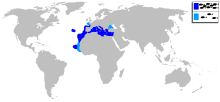Common pandora
| Common pandora | |
|---|---|

| |
| Scientific classification | |
| Domain: | Eukaryota |
| Kingdom: | Animalia |
| Phylum: | Chordata |
| Class: | Actinopterygii |
| Order: | Spariformes |
| Family: | Sparidae |
| Genus: | Pagellus |
| Species: | P. erythrinus
|
| Binomial name | |
| Pagellus erythrinus | |

| |
| Distribution of Pagellus erythrinus | |
| Synonyms[2] | |
| |
The common pandora (Pagellus erythrinus), also known as king of the breams, pandora red pandora or Spanish seabream, is a species of marine ray-finned fish belonging to the family Sparidae, which includes the seabreams and porgies. This fish is found in the eastern Atlantic Ocean and the Mediterranean Sea. It is an esteemed food fish.
Taxonomy
The common pandora was first formally described as Sparus erythrinus by Carl Linnaeus in the 10th edition of Systema Naturae published in 1758 with its type locality given as the Mediterranean and America.[3] The genus Pagellus is placed in the family Sparidae within the order Spariformes by the 5th edition of Fishes of the World.[4] Some authorities classify this genus in the subfamily Pagellinae,[5] but the 5th edition of Fishes of the World does not recognise subfamilies within the Sparidae.[4]
Etymology
The common pandora has the specific name erythrinus which means “red”, a reference to the pinkish colour of this fish.[6]
Description
The common pandora has an oval, compressed body with a straight dorsal profile to the head. The eye has a diameter that is clearly shorter than the length of the snout. The scales on the head extend forward to the level of the front edge of the eyes. The cheeks are scaled while the
Distribution and habitat
The common pandora has a wide range along the eastern shores of the Atlantic Ocean, from the coast of West Africa from Guinea Bissau north to the Strait of Gibraltar including Cape Verde, Madeira and the Canary Islands, throughout the Mediterranean Sea and into the western Black Sea and extends northward in the North Sea as far as Norway.[1] In terms of genetic diversity, there appears to be a high level of connectivity from the Atlantic through the Mediterranean.[9] This demersal fish occurs at depths down to 300 m (980 ft), although it is typically found no deeper than 100 m (330 ft), over sand, mud, rock and gravel substrates. Young fish are found farther inshore than the adults.[7]
Biology
The common pandora is a
A study in the central
As most fishes, the common pandora harbours a variety of
Fisheries
The common pandora is an important target species for fisheries in the Mediterranean and Atlantic and there are indications that the stocks are being overfished in a number of areas of the Mediterranean. In Italy this species is one of the most important species of Sparid landed but the total landing has declined fron 1,900 t (1,900 long tons; 2,100 short tons) in 2004 to 850 t (840 long tons; 940 short tons) in 2010. The EU has set a minimum size limit for this species being landed of a total length of 150 mm (5.9 in).
References
- ^ . Retrieved 12 November 2021.
- ^ a b Froese, Rainer; Pauly, Daniel (eds.) (2023). "Pagellus erythrinus" in FishBase. October 2023 version.
- ^ Eschmeyer, William N.; Fricke, Ron & van der Laan, Richard (eds.). "Species in the genus Pagellus". Catalog of Fishes. California Academy of Sciences. Retrieved 6 February 2024.
- ^ OL 25909650M.
- ^ Parenti, P. (2019). "An annotated checklist of the fishes of the family Sparidae". FishTaxa. 4 (2): 47–98.
- ^ Christopher Scharpf (12 January 2024). "Order ACANTHURIFORMES (part 6): Families GERREIDAE, LETHRINIDAE, NEMIPTERIDAE and SPARIDAE". The ETYFish Project Fish Name Etymology Database. Christopher Scharpf. Retrieved 6 February 2024.
- ^ ISBN 978-92-5-109267-5.
- ^ J-C Hureau (ed.). "Pagellus erythrinus". Fishes of the Northeastern Atlantic and Mediterranean. Naturalis Biodiversity Center. Retrieved 6 February 2024.
- S2CID 85826769.
- ^ .
- ^ Šantić, Mate; Paladin, Antonela & Radja, Biljana (2011). "Feeding habits of common pandora Pagellus erythrinus (Sparidae) from eastern central Adriatic Sea". Cybium: international journal of ichthyology. 35 (2): 83–90.
- S2CID 3516226.
- .
- "Pagellus erythrinus". Integrated Taxonomic Information System. Retrieved 1 March 2007.
- Froese, Rainer; Pauly, Daniel (eds.) (2007). "Pagellus erythrinus" in FishBase. March 2007 version.
External links
 Media related to Pagellus erythrinus at Wikimedia Commons
Media related to Pagellus erythrinus at Wikimedia Commons- Photos of Common pandora on Sealife Collection

